What is an ecommerce chatbot and why do you need one?
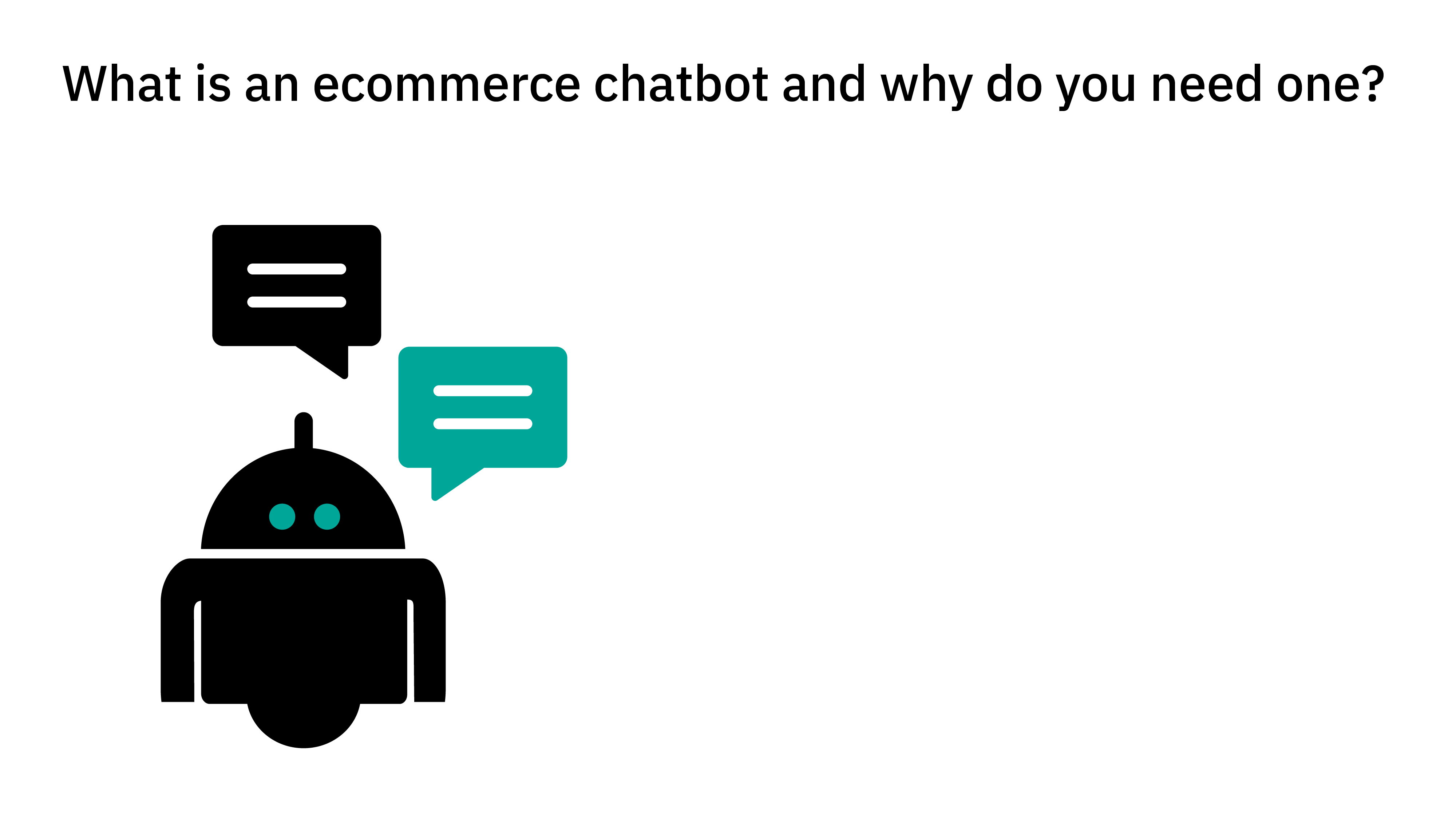
With ever-more demanding customers, the shift to online shopping, round-the-clock service, and one of the biggest booms any industry has seen in recent years, e-commerce has become a playground for digital innovation and advancement.
In particular, with huge steps being taken in the fields of machine learning, RPA, and Natural Language Understanding (NLU), AI-powered tools have emerged as kings of the sandpit. With some claiming that the market for ecommerce bots will grow to $9.4 billion by 2024, now is the time to get interested in this topic.
But what exactly is a chatbot in ecommerce, and how could it help you with your operations, or your peak management? Our guide is about to tell you just that.
What is a chatbot in ecommerce?
This is an AI-powered virtual assistant (essentially a computer program) that can simulate a human conversation. It’s designed to help ecommerce businesses automate customer service and support.
These tools are part of a movement called conversational commerce, which combines such virtual tools with other forms of communication to create a seamless customer experience.
Although there are many ways to create this kind of program - and many applications for it, which we’ll discuss later on - there are two main categories.
Rule-based.
These operate on a predetermined set of rules and are not able to understand human conversation. They tend to work based on a series of predetermined questions that are programmed to recognize specific answers, complete basic tasks, and present fixed options for users.
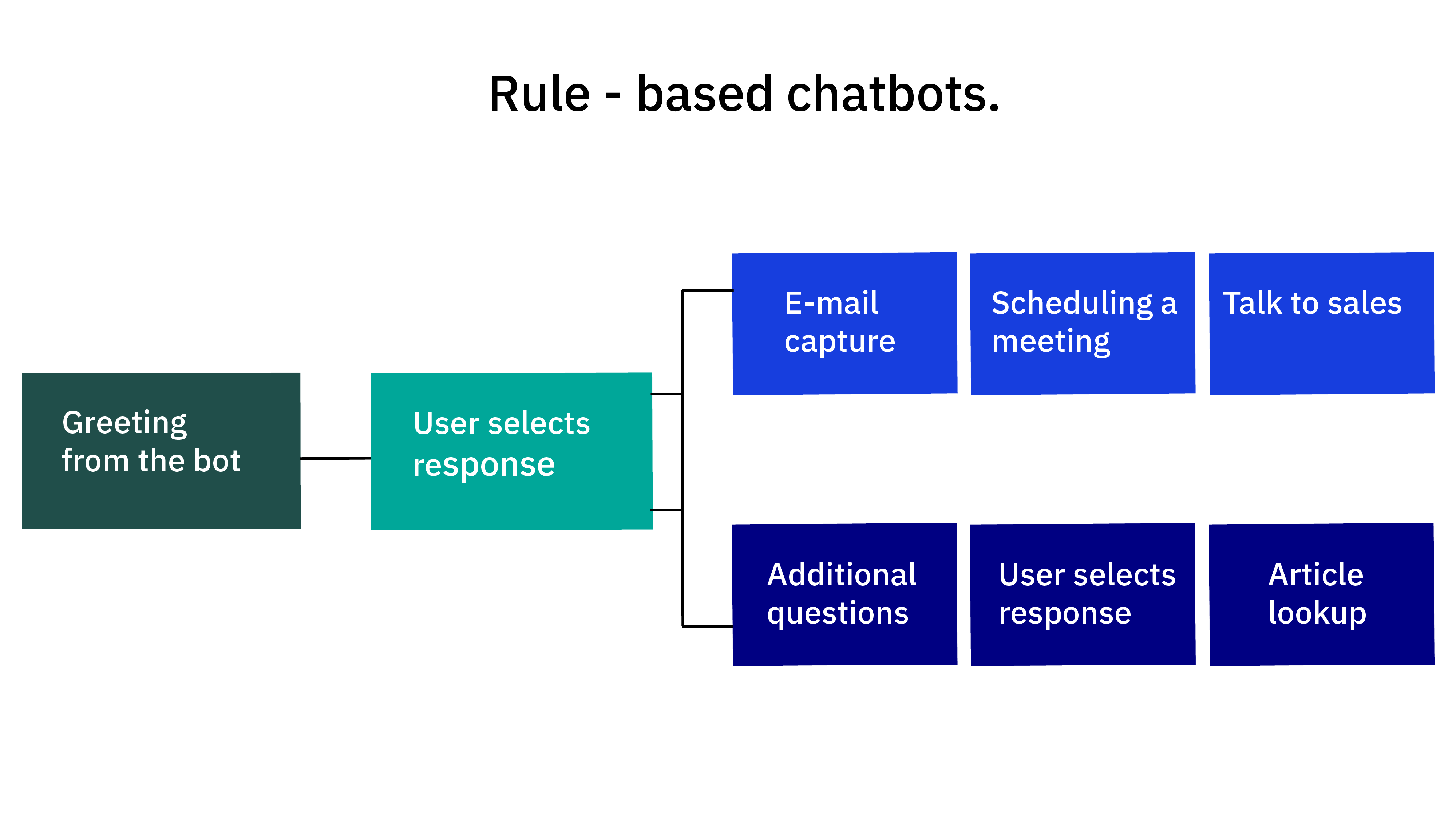
AI-based.
These use artificial intelligence (AI) to understand human conversation. They are more expensive to develop but offer a more natural conversation experience for users. Thanks to technology such as Natural Language Understanding and machine-learning, they can adapt to changes in the conversation, create a more personalized experience, and therefore provide an experience that is similar to speaking with an agent - depending on how they’re programmed
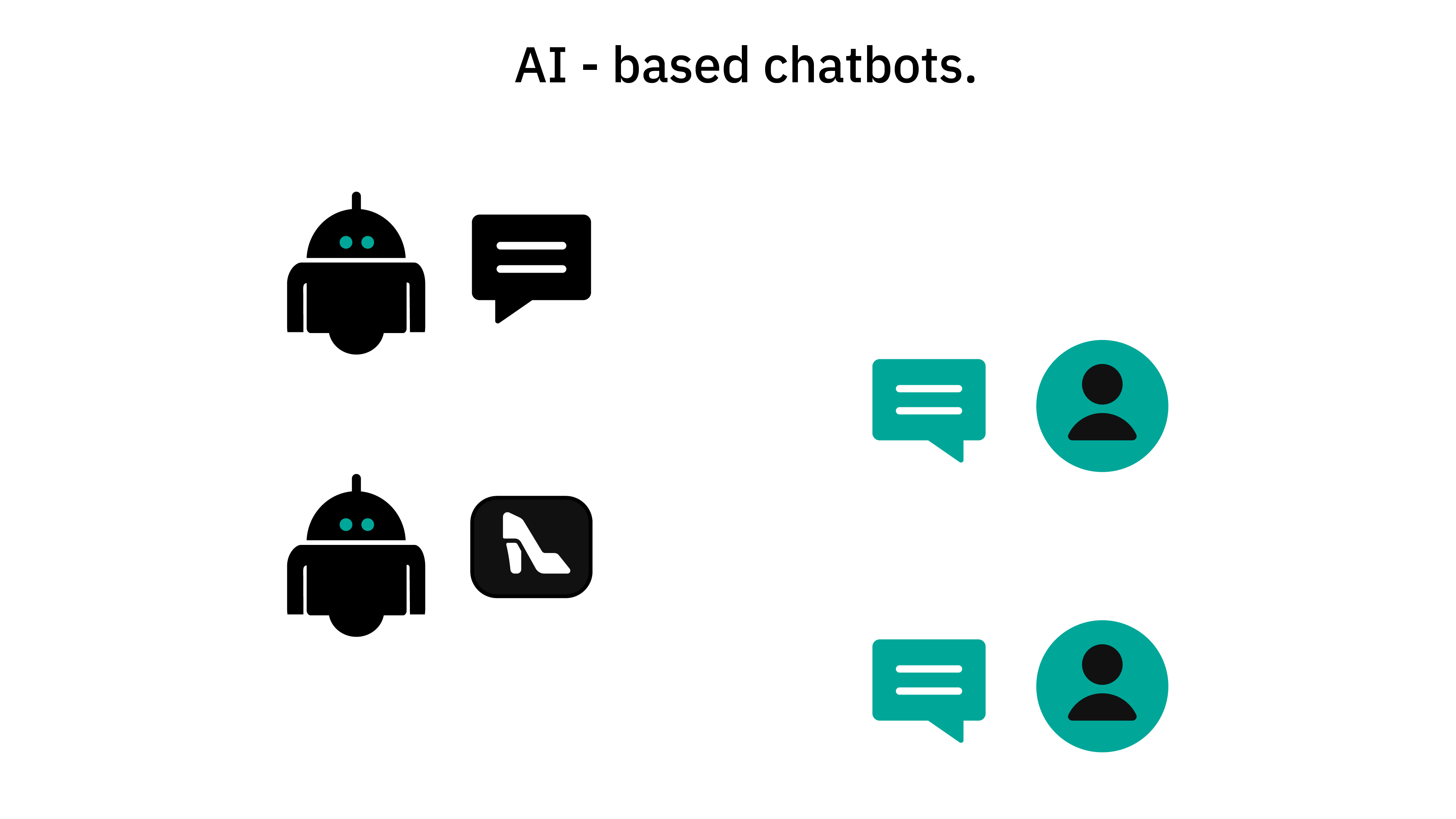
How do they work?
As we mentioned above, a chatbot in ecommerce uses artificial intelligence (AI) to understand human conversation, and then provide automated responses accordingly.
They can be developed in a number of ways, including:
- Using a chatbot platform. There are many different platforms available that you can use to create your own. These platforms will provide you with everything you need to create and manage your bot, including templates, tools, and support.
- Hiring a development company. You can also hire a development company to create a custom solution for your ecommerce business. This option will be more expensive than using a platform, but it will allow you to create a uniquely branded chatbot that is tailored to your ecommerce business.
- Using a chatbot service. You can also use a chatbot service to create and manage your electronic friend. This option is less expensive than hiring a development company, but it will require you to have some technical knowledge to set up and manage.
Depending on the path you choose, here are the basic steps you’ll need to take in order to successfully launch this tool for your business:
- Define your goals.
Before you start designing your new virtual friend, it's important to define your goals. What do you want it to achieve? Do you want to increase sales, generate leads, or improve customer service? Once you've defined your goals, you can start designing your solution with them in mind.
- Choose a platform / developer / service.
Pick what’s best for you and your business, while keeping in mind your budget. More complex tools will require more investments, and it may turn out that your goals can be achieved with a simpler service.
- Keep it simple.
When designing your chatbot, it's important to keep it simple. It should be able to accomplish its tasks without too much difficulty. If you make it too complex, it may become overloaded or make mistakes.
- Test it.
Before you launch, it's important to test it to ensure that it works as intended. You can do this by asking friends or family members to try it out and provide feedback.
- Regularly update it.
As your business changes and grows, you'll need to regularly update your bot with new information. If you don't keep the software up-to-date, it may start to provide inaccurate information to customers, which can lead to frustration and decreased sales.
The type of virtual assistant that is right for your ecommerce business will depend on your budget, the complexity of your needs, and the level of customer service that you require. If you have a limited budget, a rule-based chatbot may be a good option. If you require a more complex tool with the ability to understand human conversation, an AI-based bot may be a better option.
Of course, the cost of developing a chatbot in ecommerce will vary depending on the features and functionality that you require. Generally, the more complex the application, the more expensive it will be to develop, which is why it’s crucial to define your targets and key areas of influence.
This is why it’s crucial to work together with an experienced partner on your customer experience strategies. With a partner like Transcom, you can efficiently plan out, develop, and implement digital tools such as these, with a team that has a vast experience in developing customer journeys and applying technology to exceed customer expectations.
What are the benefits?
Ecommerce bots can save your business time and money. They can improve customer satisfaction by providing quick and efficient customer service. When programmed correctly, they can also help you generate leads and sales.
Increased sales.
One of the main benefits of these solutions is that they can help to increase sales. By providing potential customers with information about your products and services, answering their questions, and directing them to your website or landing pages, a chatbot in ecommerce can persuade customers to make purchases. One study found that 47% of users will consider purchasing items via a bot, and are willing to spend around $55 on these kinds of purchases.
Increased leads.
Chatbots can also help to generate leads by providing potential customers with information about your products and services, answering their questions, and directing them to your website or landing pages. They can also collect contact information from customers, allowing you to create personalized shopping experiences for them at a later date.
Use case - H&M.
Along with its online store, the clothing retail brand H&M developed a chatbot to act as a virtual stylist for its customers. After asking the user a series of questions to determine their fashion preferences, it’is able to build a style persona for the user and create a personalized outfit for them. The user can then choose to ‘shop’ or ‘save’ the items, with the former option redirecting them to the H&M online store, and the latter saving them for later perusal.
By creating a personalized experience for the customer, H&M can streamline sales, create an engaged online community, and most importantly, gather important data on the preferences of its shoppers to use in future promotions and communications. This kind of data-driven lead generation, wrapped in the novelty and fun of a virtual fashion consultant, is what can change the game for an ecommerce business.
Improved customer service.
A chatbot in ecommerce can help to resolve customer service issues quickly and efficiently. By taking on simple tasks, such as answering FAQs or providing product information, they can free up your human employees to focus on more complex tasks. This is particularly key during peak season, where timely responses can seriously impact customer satisfaction.
Increased efficiency and productivity.
These tools can also save your employees time by taking on simple tasks, such as answering FAQs or providing product information. This can free up your employees to focus on more complex tasks, which can lead to increased efficiency and productivity. Due to their robotic nature, these applications can also work 24/7, providing your customers with support all day and night.
Reduce cart abandonment.
According to Forrester, Forrester, 53% of online shoppers abandon their carts if they do not receive instant answers to their questions. When every transaction and interaction counts, and you’re struggling to keep your contact center staffed with enough agents to meet demand, a bot may provide relief for your teams while saving your customer relationships.
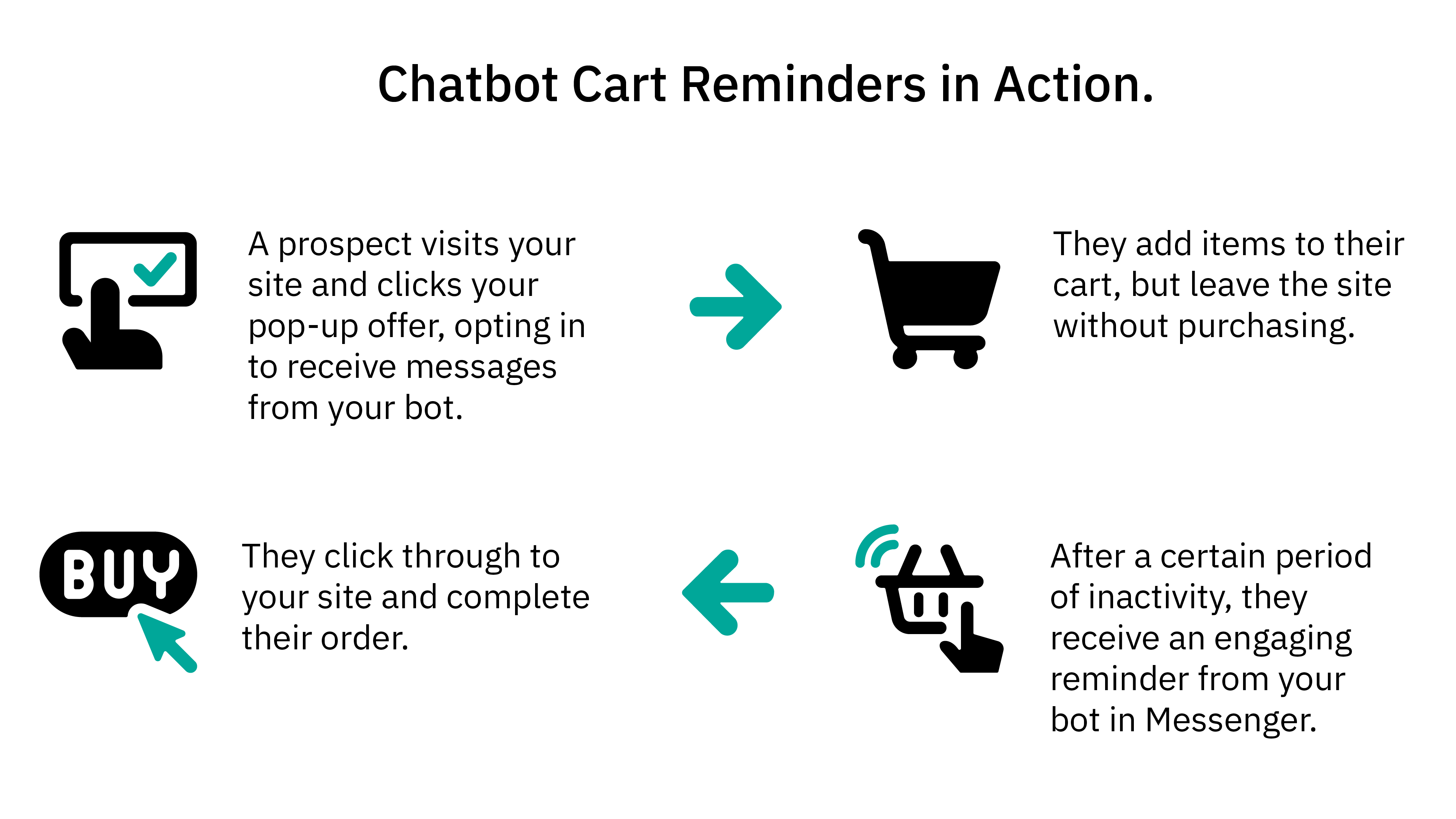
Increase ROAS.
Using a digital solution to offer customer support 24/7 can help to increase customer satisfaction and loyalty by making your brand available to consumers all the time. A chatbot in ecommerce can also offer product recommendations, thereby increasing sales and conversion rates. They’re also aces at collecting customer data, such as their preferences and interests, which can then be used to create targeted marketing campaigns that are more likely to gain results
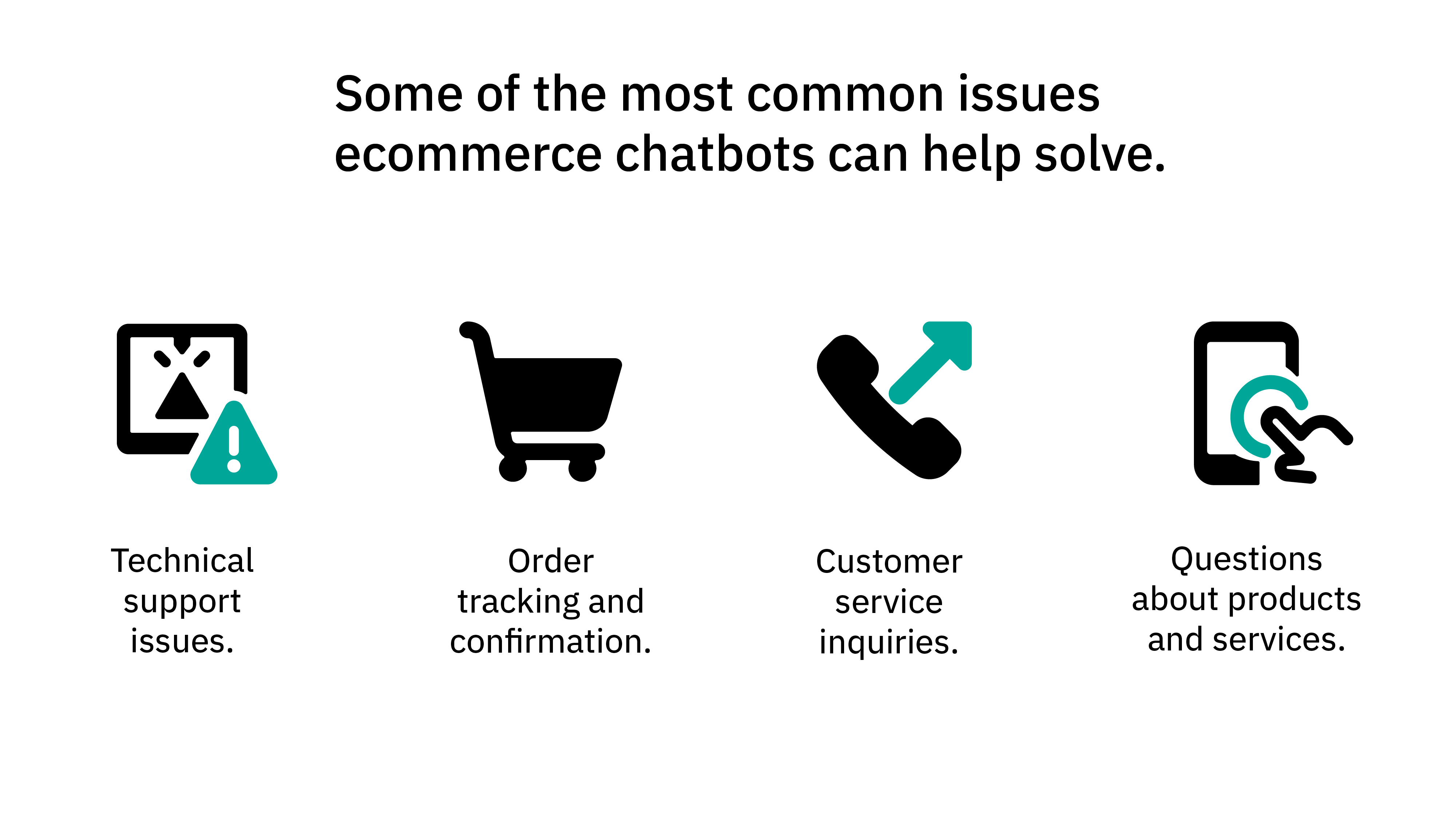
What should a chatbot be able to do?
We’ve heard all about the benefits, and we have a better handle on how these things work now. But what exactly should an AI chatbot in ecommerce be able to do for it to be successful?
Well, it may not be able to chat to you about a book you recently read and loved, but not far from it! In fact, it may be able to hear what your last read was and based on your rating of it, be able to recommend several more and even order them for you in just a few clicks.
Aside from that, here are a few key features that define a well-programmed application:
The ability to understand human conversation. This is one of the most important features of a chatbot in ecommerce. Without it, the tool will not be able to provide the level of customer service that your business needs. This is where NLU and constant development come in, as your bot learns how to interact with your users in a natural way.
The ability to handle simple tasks. Virtual assistants should be able to take on simple tasks with ease and efficiency, so that your human employees can focus on more complex tasks.
The ability to generate leads. A chatbot in ecommerce can help to generate leads by providing potential customers with information about your products and services, answering their questions, and directing them to your website or landing pages.
The ability to upsell and cross-sell products. These tools can help increase sales by upselling and cross-selling products to customers. If a consumer expresses interest in purchasing an album by their favorite artist, a bot may quickly determine they’re a fan and offer them a deal on the whole discography.
Use case - Levi’s.
The clothing retailer Levi’s was facing serious issues with their online store, including too many returns and too many cart abandonments. The company implemented a bot that quizzed customers on their body shape, preferred look, fit, and occasion for wearing jeans, before finally offering personalized jean models for them to choose from. This helped to reduce the number of returns by giving customers exactly what they wanted and needed.
The beauty of the solution is that all the recommendations are synchronized with Levi’s inventory, meaning that cart abandonments were significantly cut. Customers were only offered items that were in stock, and so were less likely to leave without making a purchase due to it being unavailable at the time. The personalized service went a long way towards improving customer satisfaction and loyalty.
The ability to handle customer service inquiries. Chatbots can help to resolve customer service issues quickly and efficiently, which could entail anything from providing information, resolving a payment issue, or tracking an order. With issues such as cart abandonment rates as high as 70%, speed and efficiency are vital.
Measuring your ROI.
Implementing a chatbot in ecommerce doesn’t have to come with huge costs, however, you’ll still want to keep track of what your investment is bringing you. There are a few key statistics to keep an eye on to ensure that your AI-powered friend is performing as planned, and give you an indication of where to tweak so that you can get the most out of this digital solution.
The number of sales generated.
One way to measure your ROI is to track the number of sales that a bot generates. If your solution is successfully convincing customers to make purchases, it will have a positive ROI.
The number of leads generated.
Another way to measure your ROI is to track the number of leads that it generates. If the application is successful at convincing potential customers to learn more about your products or services, it will have a positive ROI.
The number of customer service inquiries resolved.
You can also track the number of customer service inquiries that the bot resolves - a higher number of resolved issues equals a positive ROI.
The amount of time saved.
Chatbots can also save your employees time by taking on simple tasks, such as answering FAQs or providing product information. This can free up your employees to focus on more complex tasks, which can lead to increased efficiency and productivity.
What are some of the challenges?
We’ve spoken about all the benefits and wonderful results you might expect from using an AI chatbot in ecommerce, but surely there must be some challenges? Well, as with any new tool, there is a learning curve you may face with implementation, but these are all issues that can be managed by working with an experienced development team and trusted partners.
Transcom offers these solutions to its clients that are tailored to their business needs - and with our expert team, all of these challenges can be easily overcome.
The risk of bots becoming overloaded.
If it’is taking on too many tasks or is being used by too many customers, it may become overloaded and begin to make mistakes. This can lead to frustrated customers and decreased sales. This is when it becomes prudent to combine the solution with an omnichannel approach, IVR, and other tools that can help you to effectively manage a higher volume of inbound messages from customers.
The need for regular updates.
As your business changes and grows, your chatbot will need to be regularly updated with new information. If you don't keep it up-to-date, it may start to provide inaccurate information to customers, which can lead to them jumping ship to the competition, buying less, or overloading your human-led customer support with inquiries. Here is where an experienced partner can support in ensuring your bot is always optimized and performing to the best of its ability.
The possibility of bots making mistakes.
These are not perfect programs and may occasionally make mistakes. Whether due to poor programming, lack of optimization, or changing conditions, there’s always a chance that your bot may offer the wrong item, fail to track a shipment accurately, or malfunction altogether. Just as humans, bots aren’t perfect - but with enough attention to detail and consistency, they come very close.
Use case - PG Tips.
As part of their Comic Relief campaign in 2017, PG Tips, a British tea production company, developed a campaign which utilized its beloved mascot - the tea-loving Monkey. Users were encouraged to start a chat with Monkey online and could ask it to tell them a joke. After the joke was told, users were then presented with the option to share it on Twitter or Facebook, or make a donation to the Red Nose charity.
Whilst the campaign was overall quite successful in engaging the British public, some complaints were directed towards the bot for sending users jokes that were simply not funny or even inane. This is the perfect example of a bot that may have made mistakes and not been functional, yet still managed to make an impact as part of a targeted marketing campaign.
Despite these challenges, chatbots in ecommerce can offer a plethora of benefits to your business as noted above. Keep both the benefits and challenges in mind to help you make the best decision for your business, and to prepare yourself for the journey ahead.
How can customer feedback improve your chatbot in ecommerce?
Customer feedback is an essential part of development. By collecting feedback from your users, you can identify areas where you can improve.
There are a few different ways to collect customer feedback, including:
- Ratings. You can ask your users to rate their experience with your chatbot on a scale of 1 to 5. This can help you identify areas where you’re doing well and areas where you need improvement. Similarly to customer sentiment rating, this is a vital metric to determine whether your solution is achieving the targets you have set.
- Customer surveys. You can also send out customer surveys to collect feedback. Asking about how the persona is received, whether the bot felt natural, whether it helped solve the customer’s issue or even enhanced their experience is important data.
- Usage logs. You can also review your logs to see how bots are being used and identify areas where it can be improved. By working with a development team or a vendor, you can gain access to a variety of metrics that analyze average interaction time, resolution time, waiting times, and much more.
Some other key takeaways.
These applications can be time-limited.
Depending on what you have planned for the future, you might find that the best way your business can utilize a chatbot is for a time-limited, specific campaign. Whether it’s for marketing, as part of a test phase for customer support, or simply exploring a new channel, it may be that your tool is something that stays with you for a good time, but not a long time.
Personality is everything.
Don’t underestimate the power of character. By developing your chatbot in ecommerce with a persona in mind that is appropriate for your target audience, you can increase interest, customer loyalty, and satisfaction all in one fell swoop.
Use case - LEGO.
Ralph the chatbot was first rolled out by LEGO, the multinational toy maker, to help with Christmas sales in 2017. LEGO spent a lot of time developing an appealing character and personality that would remain distinct in the minds of its consumers, and the result was a 25% in all social media sales and a 71% reduction in cost per conversion.
What we can all learn from Ralph, is that having a distinct character can be a huge boon, and may even make your customers more forgiving in the face of potential malfunctions or errors. For some, AI-powered pals may be a tough pill to swallow, but putting a friendly face to them can help ease the transition.
Don’t be afraid to make mistakes.
This technology is constantly evolving, adapting, changing. What this means is that ideas and tools that work now may become obsolete very soon. Make sure you keep up with the latest trends in this area, to ensure you don’t fall behind.
Bots need human friends.
As much as all the benefits of an AI chatbot in ecommerce may have you thinking that they’re an excellent alternative to agent interactions, the truth is that both have to work in tandem. A bot can streamline your operations, increase efficiency, and take some of the workload off your human team's shoulders. However, you still need people who can direct it, program it, and in case a customer prefers interacting with another person, step in to help.